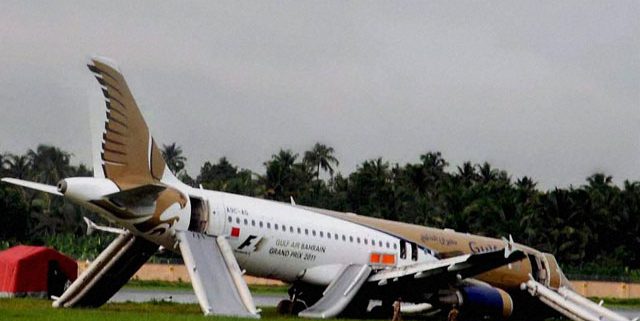Unusual attitudes, and we don’t mean the flight attendants!
Image Credit: PTI
Should flight attendants be taught unusual aircraft attitudes post-landing during training?
Yes, flight attendants should be taught what to expect on aircraft should there be landing gear damage or failure, causing the aircraft to be angled in a way different than perfectly horizontal. The larger the aircraft, the steeper or more shallow the slide can be when a nose gear or landing gear is collapsed.
The topic of unusual attitudes training is implied, found in FAA Order 8900.1 Volume 3, Chapter 23, Section 4 Flight Attendant General Emergency Training. Look in paragraph 3-1797. 6), “Emergency Exits” and 7) “Exits Without Slides,” which states “operation, including positioning, under adverse conditions (aka. unusual attitudes post-crash). Related suggested content is also found in the same Volume/Chapter/Section 3-1798 5) Evacuation techniques – Aircraft Landing Attitudes:
Inflight training department managers may think, “An aircraft comes to rest in an unusual attitude, so? Redirect, it’s that simple.” That’s how experienced management may think; that’s not how a new-hire flight attendant thinks. Not just that, but anyone, new hire and experienced flight attendants may or may not have good judgment. Some things need more explicit discussion and explanation. Judgment comes from experience, and when will they ever gain experience in emergency evacuations and unusual aircraft attitudes? How a flight attendant will react under actual conditions is unknown. The door drill practice provides some potential insight, but only into those that are inherently emotionally incapable of handling stress. Actual actions a flight attendant will take and how to respond to an emergency is what needs to be addressed in training. Teach them well and they will [likely] perform well under stress. In many interviews with flight attendants that experienced an emergency evacuation or event during flight, many of them attributed their successful performance to the training they received. They knew what to expect, they knew what was normal, and were able to stay focused because they knew “that was supposed to happen.”
Redirecting is one method for dealing with an unusual attitude. Sometimes the slide may be steeper than normal, making it still usable. What changes when the slides have a different attitude than standard are the evacuation commands. Instead of flight attendants shouting at passengers to jump and slide, they may need to command passengers to sit and slide to get out. If flight attendants are not taught this in advance, they may not figure it out on their own when under high stress to evacuate the plane. If the nose gear is collapsed, instead of jump and slide, it can become “run and get away!”
Well-trained flight attendants are necessary under normal conditions and put to the test under adverse or emergency conditions. That is not the time to question yourself, “did we teach them well enough? After all, we did tell them to use their judgment.” For flight attendants to have superior judgment, they need excellent, thorough training as their foundation to develop that judgment skill.
Here are some articles of aircraft evacuations that were non-standard with unusual attitudes, causing a modification in evacuation commands and techniques. You can see by the slide angle, they could not use typical commands, “jump, get away!”
AVHerald: Gulf Air, August 29, 2011, Kochi, India
Skybrary: Hapag-Lloyd, July 12, 2000, enroute to Vienna, Austria
Asiana, July 6, 2013, San Francisco, USA
Airline Reporter: Asiana, July 6, 2013
In addition to these articles with images, Google search for these accidents and you’ll find many more photos of the accidents.
Image credit comes from Gulf News





Leave a Reply
Want to join the discussion?Feel free to contribute!